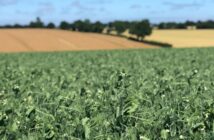In a landmark discovery for global wheat production an international consortium of crop researchers, including NIAB in the UK, have sequenced the genomes for 15 important wheat varieties used in breeding programmes around the world.
The results will enable plant scientists and breeders to much more quickly identify influential genes for improved yield, pest resistance and other important crop traits.
The research results, just published in the journal ‘Nature’, provide the most comprehensive atlas of wheat genome sequences ever reported. The Wheat 10+ Genomes Project collaboration was led by researchers at the University of Saskatchewan Crop Development Centre (USask CDC) in Canada and involved universities and institutes in Switzerland, Germany, Japan, the UK, Saudi Arabia, Mexico, Israel, Australia, and the USA. NIAB was part of a Biotechnology and Biological Sciences Research Council-funded team, led by Dr Matt Clark at the Natural History Museum, Dr Bernado Clavijo at the Earlham Institute, Professor Mike Bevan at the John Innes Centre and Dr James Cockram at NIAB, that contributed by sequenced the globally important spring wheat variety ‘Weebill 1’.
“Bred by the International Centre for the Improvement of Maize and Wheat (CIMMYT) in Mexico over ten years ago, ‘Weebill 1’ has good yield coupled with drought and leaf rust pathogen resistance, and is already used in breeding programmes worldwide. Its genome assembly, as part of this ‘pan-genome’ of multiple wheat genome sequences, will help breeders and researchers identify these useful, and possibly unique, genomic loci to incorporate into wheat breeding programmes. This was one of the five wheat varieties that groups within the UK contributed to the sequencing project, highlighting the UK’s strong commitment to international wheat research,” explained NIAB’s lead researcher Dr Cockram (pictured).
CDC’s wheat breeder and director and project leader Dr Curtis Pozniak said, “This mass sequencing project is like finding the missing pieces for your favourite puzzle that you have been working on for decades. By having many complete gene assemblies available, we can now help solve the huge puzzle that is the massive wheat pan-genome and usher in a new era for wheat discovery and breeding.”
Scientific groups across the global wheat community will use these new resources to identify genes linked to in-demand traits, so helping to accelerate breeding efficiency. It enables researchers to more precisely control breeding to increase the rate of wheat improvement for the benefit of farmers and consumers, and meet future food demands.
“Having multiple wheat genome sequences enables us to identify genetic differences between wheat lines that are important for breeding. We can now compare and contrast the full complement of the genetic differences that make each variety unique. For example, understanding a causal gene for say insect resistance is a game-changer for breeding because you can select for pest resistance more efficiently by using a simple DNA test than by manual field testing,” said Dr Pozniak.
The usefulness of the resources generated was demonstrated within the project with the identification of a gene controlling wheat resistance to an important insect pest of wheat, orange blossom midge, allowing genetic markers to be developed that allow beneficial natural variants at this gene to be efficiently tracked within breeding programmes. “We expect researchers across the world to exploit these sequenced resources in similar ways, resulting in further insights and tools that will help the continued development of wheat varieties with improved performance,” explained Dr Keith Gardner, a co-investigator on the project at NIAB.
Dr Cockram also highlights how such research breakthroughs are all part of the fight to mitigate climate change by increasing the resilience of crops across the world. “Improved plant varieties may have a better capacity to withstand pests and diseases, while using fewer resources. They could also offer stable yields in an unstable climate and improve productivity through efficient use of water, land and nutrients,” he finished.




